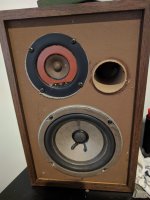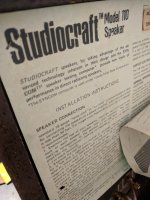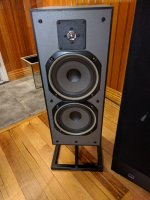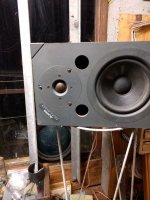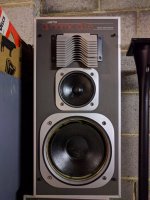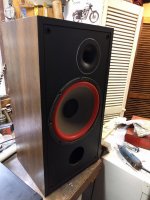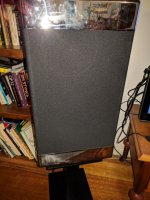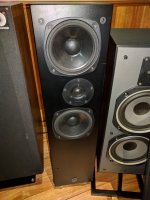are these the speakers in question
These ones.
Attachments
I repaired a set of those for a customer a while back. The woofers needed refoaming and also the cone neck/voice coil junction needed reinforcing with a suitable glue, because that area had started to crease and flex and complete failure was imminent.
That cone tweeter is commonly called a "phenolic ring tweeter" due to the fact it has a rigid piece of tan coloured phenolic material as the outside support for the tweeter cone.
That cone tweeter is commonly called a "phenolic ring tweeter" due to the fact it has a rigid piece of tan coloured phenolic material as the outside support for the tweeter cone.
Jaycar or WES PP caps are fine especially for the spend.I'm buying Capacitors of the same value for other projects.
I might slip one into the Studiocrafts to listen for any improvement, otherwise I think I'll leave them as they are.
One easy and useful mod is to fit 100R across speaker input terminals, 0.6W is enough power rating for low level listening, 5W WW for full power usage.
Supply chain markups cause a $3.00PP cap to become a $30.00 cap at retail.So many respected brands have sold their souls to the $.
Many pump out offerings built to a price rather than a standard.
In my experience most older speakers require improvement, mostly replacing BP electros with PP but uF values may need to be tweaked.Just curious why old speakers aren't worth improving?
Max.
Thanks Max
I'm not up to hifi jargon/abbrev.
What is "100R" & "WW"?
Are you saying to place this part across the internal section of the +ve & -ve speaker binding posts?
What improvement will be achieved from this?
Without microphone/software to test speaker performance, how do you recommend going about tweaking with uF values?
cheers
Cliff
One easy and useful mod is to fit 100R across speaker input terminals, 0.6W is enough power rating for low level listening, 5W WW for full power usage.
I'm not up to hifi jargon/abbrev.
What is "100R" & "WW"?
Are you saying to place this part across the internal section of the +ve & -ve speaker binding posts?
What improvement will be achieved from this?
In my experience most older speakers require improvement, mostly replacing BP electros with PP but uF values may need to be tweaked.
Max.
Without microphone/software to test speaker performance, how do you recommend going about tweaking with uF values?
cheers
Cliff
To check crossover point just use your phone. Download a free app for frequency analysis a play some white noise or sweep
Cool. 100 ohms WireWound, usually 5W rated white ceramic body, easily available from Jaycar for 48c.Thanks Max.
I'm not up to hifi jargon/abbrev.
What is "100R" & "WW"?
Yes directly across the binding posts, if you fit them to the outside of the binding posts you can AB compare easily.Are you saying to place this part across the internal section of the +ve & -ve speaker binding posts?
What improvement will be achieved from this?
Such resitor provides a load to terminate the cable at high frequencies and quench RF pickup that can cause subtle noise in some amps.
Doing this helps with taming highs harshness, you can additionally do this directly across each crossover output or directly across each driver but this will skew crossover points slightly.
0.5W Metal Film are fine for Mid and High drivers.
Tweeter and mids series PP caps have less losses than BiPolar Electros so when doing a straight same value swap mids and highs generally brighten up and with lower distortion and that will change the overall timbre of the speaker.Without microphone/software to test speaker performance, how do you recommend going about tweaking with uF values?
cheers.Cliff
This extra brightness and clarity might be ideal for you and your room or it might be too much which is when you can reduce the cap value to the next lower value and see what you reckon, you can also parallel values to home in on the sound you like.
Large value shunt electros can be bridged with PP caps and this usually improves sound also.
The phone Analyser app is a good suggestion to measure where your experiments are heading, but ultimately your ears are the final judge, it is useful to have other liked or preferred speakers to use as reference or reality check lol.
The Jaycar PP caps are readily available but cheaper Ebay PP ones are fine, 63V or 100V is plenty voltage rating.
Have fun hotrodding old speakers, you will learn stuff, if the drivers are reasonably ok you can get surprisingly good sound for little outlay.
One word, do one mod at a time on one speaker only and listen for day or two before deciding on new settings and committing to the other speaker.
Max.
Thanks Max.
Thanks Max.
Seems a very inexpensive and easy way of improving some speakers.
Others have said that the cheaper end of the Resistor market can introduce inductance which has its own issues.
What are your thoughts about adding a few cents more and going for this style of resistor?
5W Superes 100 Ohm
This example fits into the recommended 5 watt 100 ohm.
Most of the crossovers I've been assessing have Sandcast Resistors mostly fitted between an Inductor and the -ve Binding post terminal.
Is your suggested tweak doubling up, or can I add as per your instruction?
I am looking for extra brightness and clarity from my Soundynamics which have good bass but very flat in the treble.
What does paralleling do to the sound?
For example, if I replaced an electrolytic μF Capacitor with PP of the same value, what would I parallel with the PP, and in which direction would that take the sound?
By "shunt electros" do you mean large value electrolytic Caps?
Are these used due to technical issues restricting PP to relatively low values?
Can you give an example?
What is bridged vs parallel?
What values are you recommending?
Thanks for your welcomed technical input.
Cliff
Cool. 100 ohms WireWound, usually 5W rated white ceramic body, easily available from Jaycar for 48c.
Yes directly across the binding posts, if you fit them to the outside of the binding posts you can AB compare easily.
Such resitor provides a load to terminate the cable at high frequencies and quench RF pickup that can cause subtle noise in some amps.
Doing this helps with taming highs harshness, you can additionally do this directly across each crossover output or directly across each driver but this will skew crossover points slightly.Max.
Thanks Max.
Seems a very inexpensive and easy way of improving some speakers.
Others have said that the cheaper end of the Resistor market can introduce inductance which has its own issues.
What are your thoughts about adding a few cents more and going for this style of resistor?
5W Superes 100 Ohm
This example fits into the recommended 5 watt 100 ohm.
Most of the crossovers I've been assessing have Sandcast Resistors mostly fitted between an Inductor and the -ve Binding post terminal.
Is your suggested tweak doubling up, or can I add as per your instruction?
Tweeter and mids series PP caps have less losses than BiPolar Electros so when doing a straight same value swap mids and highs generally brighten up and with lower distortion and that will change the overall timbre of the speaker.
This extra brightness and clarity might be ideal for you and your room or it might be too much which is when you can reduce the cap value to the next lower value and see what you reckon, you can also parallel values to home in on the sound you like.Max.
I am looking for extra brightness and clarity from my Soundynamics which have good bass but very flat in the treble.
What does paralleling do to the sound?
For example, if I replaced an electrolytic μF Capacitor with PP of the same value, what would I parallel with the PP, and in which direction would that take the sound?
Large value shunt electros can be bridged with PP caps and this usually improves sound also.
Max.
By "shunt electros" do you mean large value electrolytic Caps?
Are these used due to technical issues restricting PP to relatively low values?
Can you give an example?
What is bridged vs parallel?
What values are you recommending?
Thanks for your welcomed technical input.
Cliff
Last edited:
Yes that's the point.Thanks Max.
Seems a very inexpensive and easy way of improving some speakers.
The Jaycar ones are low inductance but least inductance is best.Others have said that the cheaper end of the Resistor market can introduce inductance which has its own issues.
What are your thoughts about adding a few cents more and going for this style of resistor?
5W Superes 100 Ohm
This example fits into the recommended 5 watt 100 ohm.
I am saying 100R across input to crossover and optionally electrically across each driver, nothing to do with existing resistors.Most of the crossovers I've been assessing have Sandcast Resistors mostly fitted between an Inductor and the -ve Binding post terminal.
Is your suggested tweak doubling up, or can I add as per your instruction?
You can however also change out existing white ceramic resistors with the type you linked to but with suitable/same values.
Different resistor types will sound different, getting the sound you want is the art.
I am looking for extra brightness and clarity from my Soundynamics which have good bass but very flat in the treble.
What does paralleling do to the sound?
For example, if I replaced an electrolytic μF Capacitor with PP of the same value, what would I parallel with the PP, and in which direction would that take the sound?
By "shunt electros" do you mean large value electrolytic Caps?
Are these used due to technical issues restricting PP to relatively low values?
Can you give an example?
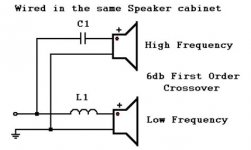
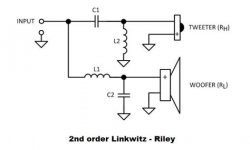
No, not need to bridge new PP with smaller PP, but changing BP to same value PP will brighten the highs possibly too much.
I am saying to shunt larger value electros with 1.0uF is useful.....large values like 10uF and up get expensive in PP so keep using BP and add PP to brighten up and clean.
These large cap values are usually shunt caps such as C2, series caps are usually manageable values.
Same thing as is shunt.What is bridged vs parallel?
0.47uf or 1.0uFWhat values are you recommending?
You are welcome to ask more advice, you do need to do some learning of DC Theory and AC Theory.Thanks for your welcomed technical input.
Cliff
You are welcome to ask more advice.
Thanks Max
Some of my speaker cabinets are lacking in insulation material.
Also a couple of of them only have material placed on rear bottom and top surfaces.
In others, the material is quite thin.
What material do you recommend which might be readily and inexpensively available in Oz to line cabinets with?
What insulation thicknesses do you recommend?
All speaker cabinets I have are of ported design.
thanks
Yup, much variability, economics is part of it.Thanks Max
Some of my speaker cabinets are lacking in insulation material.
Also a couple of of them only have material placed on rear bottom and top surfaces.
In others, the material is quite thin.
Many English speakers were fully lined with 1.5" or so yellow foam and this works, there is eggshell foam too and you might some for free in mattress toppers etc.What material do you recommend which might be readily and inexpensively available in Oz to line cabinets with?
What insulation thicknesses do you recommend?
All speaker cabinets I have are of ported design.
thanks
White polyester fill is another damping material, I have thought about glueing carpet tiles inside the panels but not tried it yet.
DO NOT repeat DO NOT use fibreglass batts in ported boxes, every bass beat will puff fine glass fibres into the room !.
Another subject is internal wiring for this I recommend Jaycar clear insulated fig8 cable.
Remember it's not a matter of more is better. Only covering the back is quite normal. You can get adhesive foam for car insulation. It's quite cheap, or egg foam for studio accustic treatment. This is also quite cheap
1Roll 20mm Car Sound Proofing Deadening Insulation Closed Cell Foam Noise AB | eBay
1Roll 20mm Car Sound Proofing Deadening Insulation Closed Cell Foam Noise AB | eBay
Last edited:
You can just do a quick test with using a bathroom towel. Just tape it on the back , then the sides, and even the top or bottom. On the inside of course. This would let you hear if you would get any type of positive difference. Then use a better type of sound dampening material
Yup, much variability, economics is part of it.
Many English speakers were fully lined with 1.5" or so yellow foam and this works, there is eggshell foam too and you might some for free in mattress toppers etc.
White polyester fill is another damping material, I have thought about glueing carpet tiles inside the panels but not tried it yet.
DO NOT repeat DO NOT use fibreglass batts in ported boxes, every bass beat will puff fine glass fibres into the room !.
Another subject is internal wiring for this I recommend Jaycar clear insulated fig8 cable.
Thanks Max.
Well try the 5 watt 100 ohm resisters, and work towards tracking down suitable damping material.
Also I'll experiment with 0.47uf or 1.0uF PP's.
And I'll stock up on clear figure 8 cable.
Much obliged for your experience.
Last edited:
To check crossover point just use your phone. Download a free app for frequency analysis a play some white noise or sweep
Thanks K.
I've had issues with online banking and these days very reluctant to download from unsecured websites.
Non the less good advice.
I'll try to get such a recording on disc or memory stick.
cheers
Cliff
You can just do a quick test with using a bathroom towel. Just tape it on the back , then the sides, and even the top or bottom. On the inside of course. This would let you hear if you would get any type of positive difference. Then use a better type of sound dampening material
thanks carl.
Interesting method.
I don't think my wife would be too happy. 🙂
I do have some yellow foam out of an old couch.
Will give this a go.
Different resistor types will sound different, getting the sound you want is the
Just a quick one Max.
If I can get a 10 watt resistor with the same Ω rating as a 5 watt what is the science behind choosing?
Is it a question of size, or is it down to the art of choosing the one which sounds best, and/or is there a technical reason?
thanks
C
Jaycar Heavy Duty Fig 8 Speaker Cable is plenty of copper, one tip is make sure all cables sections are running in the same direction including amp to speaker eg if the labelling reads Jaycar Cable the 'Jaycar' ends facing the amp output and crossover outputs and 'Cable' facing to speaker box input and each driver terminals.Will try the 5 watt 100 ohm resisters, and work towards tracking down suitable damping material.
Also I'll experiment with 0.47uf or 1.0uF PP's.
And I'll stock up on clear figure 8 cable.
Bigger component means bigger loop area which means more inductance.If I can get a 10 watt resistor with the same Ω rating as a 5 watt what is the science behind choosing?ing the one which sounds best, and/or is there a technical reason?.
There are all kinds of resistors to choose from IME white rectangular WW are fine enough but experiment with what you can get hold of, the tubular ones you linked should be fine, IME avoid Metal Oxide however Metal Film are ideal except for power rating but good for mids/tweeters especially if you connect several in parallel.
What speakers do you have, can you post some pics ?.
What speakers do you have, can you post some pics ?.
Hi Max
Sound Dynamics 700 Concert Speakers
Studiocraft SC110 Monitors
Mordaunt Short MS 45Ti
Jamo Dynamic D3e
Wharfedale Diamind 111
Dali 505
Alesis Pointseven Studio Monitors
Gale GS401A Speakers.
There are others but I can work on them later.
Attachments
Last edited:
That's quite a collection by the time you get through tweaking these speakers you ought to be quite the expert !.
Certainly you will learn much about voicing speakers and getting them to sound how you like them.
Here's some more links - METALISED POLYPROPYLENE MPT
5W NON-INDUCTIVE WIRE WOUND
Max.
Certainly you will learn much about voicing speakers and getting them to sound how you like them.
Here's some more links - METALISED POLYPROPYLENE MPT
5W NON-INDUCTIVE WIRE WOUND
Max.
Hi Max
Is cable directionality critical with copper cables, Jaycar, or other?
Can resistors fail, creating a short between the Speaker terminals resulting in Amp damage?
thanks
Cliff
Jaycar Heavy Duty Fig 8 Speaker Cable is plenty of copper, one tip is make sure all cables sections are running in the same direction including amp to speaker eg if the labelling reads Jaycar Cable the 'Jaycar' ends facing the amp output and crossover outputs and 'Cable' facing to speaker box input and each driver terminals.
Is cable directionality critical with copper cables, Jaycar, or other?
Yes directly across the binding posts, if you fit them to the outside of the binding posts you can AB compare easily.
Such resistor provides a load to terminate the cable at high frequencies and quench RF pickup that can cause subtle noise in some amps.
Doing this helps with taming highs harshness, you can additionally do this directly across each crossover output or directly across each driver but this will skew crossover points slightly..
Can resistors fail, creating a short between the Speaker terminals resulting in Amp damage?
thanks
Cliff
- Home
- Design & Build
- Parts
- Help to identify parts in my Studiocraft 110 Studio Monitors.
